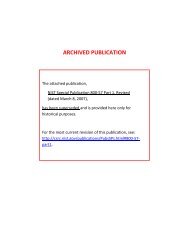NISTIR 7298 Revision 1, Glossary of Key Information Security Terms
NISTIR 7298 Revision 1, Glossary of Key Information Security Terms
NISTIR 7298 Revision 1, Glossary of Key Information Security Terms
You also want an ePaper? Increase the reach of your titles
YUMPU automatically turns print PDFs into web optimized ePapers that Google loves.
NIST IR <strong>7298</strong> <strong>Revision</strong> 1, <strong>Glossary</strong> <strong>of</strong> <strong>Key</strong> <strong>Information</strong> <strong>Security</strong> <strong>Terms</strong><br />
Cryptographic Module <strong>Security</strong><br />
Policy –<br />
Cryptographic Module Validation<br />
Program (CMVP) –<br />
Cryptographic Net – Stations holding a common key.<br />
SOURCE: CNSSI-4009<br />
A precise specification <strong>of</strong> the security rules under which a<br />
cryptographic module will operate, including the rules derived from<br />
the requirements <strong>of</strong> this standard (FIPS 140-2) and additional rules<br />
imposed by the vendor.<br />
SOURCE: FIPS 140-2<br />
Validates cryptographic modules to Federal <strong>Information</strong> Processing<br />
Standard (FIPS) 140-2 and other cryptography-based standards. The<br />
CMVP is a joint effort between National Institute <strong>of</strong> Standards and<br />
Technology (NIST) and the Communications <strong>Security</strong> Establishment<br />
(CSE) <strong>of</strong> the government <strong>of</strong> Canada. Products validated as<br />
conforming to FIPS 140-2 are accepted by the federal agencies <strong>of</strong><br />
both countries for the protection <strong>of</strong> sensitive information (United<br />
States) or Designated <strong>Information</strong> (Canada). The goal <strong>of</strong> the CMVP<br />
is to promote the use <strong>of</strong> validated cryptographic modules and provide<br />
federal agencies with a security metric to use in procuring equipment<br />
containing validated cryptographic modules.<br />
SOURCE: FIPS 140-2<br />
Cryptographic Period – Time span during which each key setting remains in effect.<br />
SOURCE: CNSSI-4009<br />
Cryptographic Product – A cryptographic key (public, private, or shared) or public key<br />
certificate, used for encryption, decryption, digital signature, or<br />
signature verification; and other items, such as compromised key lists<br />
(CKL) and certificate revocation lists (CRL), obtained by trusted<br />
means from the same source which validate the authenticity <strong>of</strong> keys<br />
or certificates. Protected s<strong>of</strong>tware which generates or regenerates<br />
keys or certificates may also be considered a cryptographic product.<br />
SOURCE: CNSSI-4009<br />
Cryptographic Randomization – Function that randomly determines the transmit state <strong>of</strong> a<br />
cryptographic logic.<br />
SOURCE: CNSSI-4009<br />
Cryptographic <strong>Security</strong> – Component <strong>of</strong> COMSEC resulting from the provision <strong>of</strong> technically<br />
sound cryptographic systems and their proper use.<br />
SOURCE: CNSSI-4009<br />
Cryptographic Strength – A measure <strong>of</strong> the expected number <strong>of</strong> operations required to defeat a<br />
cryptographic mechanism.<br />
SOURCE: SP 800-63<br />
Pg 54

















